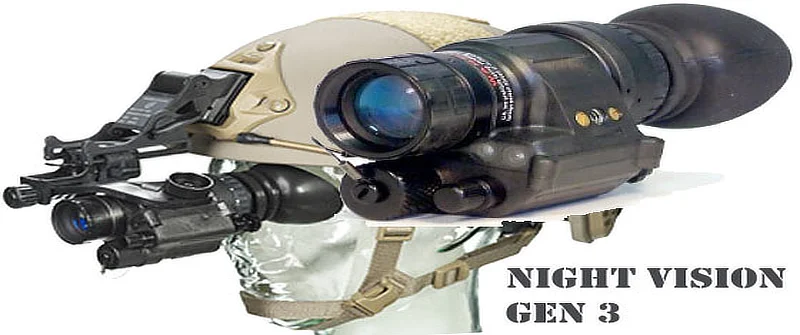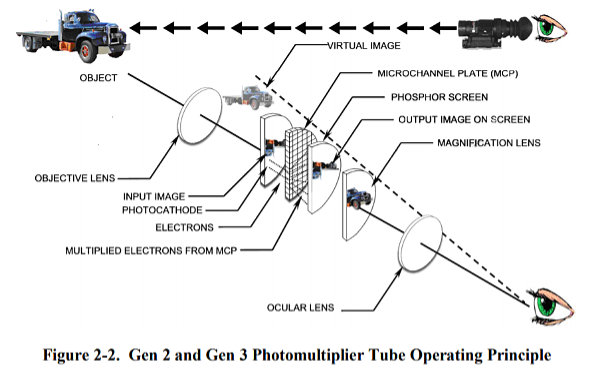Night Vision Goggles | Gen 0 to Gen 3+ | How It Works

Night vision goggles (NVG), also known as a night vision device (NVD), binocular night vision device (BNVD), or a night optical/observation device (NOD). How do they work? This optoelectronic device allows images to be produced in light levels approaching total darkness.
There are many uses for a night vision device (NVD). Military, law enforcement, security, surveillance, search and rescue, hunting, wildlife observation, navigation, hobby, preparedness for SHTF, and more.
A night vision device can be an expensive investment. But it could prove itself invaluable under some circumstances.
Here’s information on how night vision devices work, and the various generations’ technology differences (GEN-0,1,2,3,..).
I own a Gen 3+ night vision device. It’s a PVS-14, white phosphor, aviation-grade NVD. It was expensive, but I will never regret the investment.
How Night Vision Works
A night vision device is an electro-optical image enhancement technology system that enhances vision.
Night Vision Devices include Image Intensifier ( I2 ) technology. I2 technology enhances vision with very little light or levels of light approaching total darkness.
A lens captures ambient light (and some near-infrared light). The Image-intensifier tube (I2 technology) gathers and AMPLIFIES the light.
The image-intensifier tube has a photocathode. It converts the photons of light into electrons.
As the electrons pass through the tube, they are amplified by a factor of thousands.
At the end of the image-intensifier tube, the electrons hit a screen coated with phosphors. This provides the image and is viewable via another lens. These phosphors create the green image that has come to characterize night vision. Newer NVDs are now available with white phosphor (some advantages over green). I have one of those. Love it.
The AA-size or CR-123 type battery provides power for most current night vision devices.
Night Vision Devices (NVDs) have been around for more than 40 years and are categorized by generation (GEN). Each substantial change in night vision device technology establishes a new generation.
Generation-0 (GEN 0) Night Vision – NVD
GEN-0 The original night-vision system was created by the United States Army. Used in World War II and the Korean War. These NVDs use active infrared as a light source.
An IR (Infrared) Illuminator is attached to the NVD. It projects out a beam of infrared light, similar to the beam of a normal flashlight. This infrared light is invisible to the naked eye. But this beam reflects off objects and bounces back to the lens of the NVD.
These original systems (tubes) use an ‘anode’ and a ‘cathode’ to accelerate the electrons. One problem with that approach is the acceleration of the electrons distorting the image and greatly decreasing tube life. There was another major problem with this technology… Hostile nations quickly duplicated it. This allowed enemy soldiers to use their own NVDs to see the infrared beam being projected by the device from “the other side”.
Generation-1 (GEN 1) Night Vision – NVD
GEN-1 The next generation of NVDs moved away from ACTIVE infrared, using PASSIVE infrared instead. Once dubbed “Starlight” by the U.S. Army, these NVDs use ambient (infrared) light from the moon and stars. This enhanced the reflected infrared in the given environment.
A GEN-1 NVD did not require a source of projected infrared light. This also means that they do not work very well on cloudy or moonless nights. Generation-1 NVDs use the same image-intensifier tube technology as Generation 0, with both cathode and anode. So image distortion and short tube life are still a problem.
Generation-2 (GEN 2) Night Vision – NVD
GEN-2 Major improvements in image-intensifier tubes resulted in Generation-2 NVDs. They offer improved resolution and performance over Generation-1 devices and are considerably more reliable.
The biggest gain in Generation 2 is the ability to see in extremely low light conditions. A moonless night, for example. This increased sensitivity is due to the addition of a ‘microchannel’ plate to the image-intensifier tube. This plate actually increases the number of electrons instead of just accelerating the original electrons. Therefore the images are significantly less distorted and brighter than earlier-generation NVDs.

Generation-3 (GEN 3) Night Vision – NVD
GEN-3 Currently used by the U.S. military. There are no major changes in the underlying technology from Generation 2. However, these NVDs have even better RESOLUTION and SENSITIVITY.
The biggest GEN-3 change here is the photocathode composition. Gallium Arsenide. This is very efficient at converting photons to electrons, providing better resolution and sensitivity. Additionally, the micro-channel plate is coated with an ion barrier. This dramatically increases the life of the tube.
Generation-4 (GEN 3+) Night Vision – NVD
GEN-4 The military dropped the term, GEN 4. Instead, refers to the technology as GEN 3+ with “filmless” and “gated” (autogated) tubes. GEN3+ is currently used in the US Military, particularly by special operators. The technology shows a significant overall improvement in both low- and high-level light environments.
The ion barrier that was added to the micro-channel plate in the previous generation was removed. This reduces the background noise and enhances the signal-to-noise ratio. Removing the ion film also allows more electrons to reach the amplification stage. The result is brighter images with significantly less distortion.
The addition of an automatic gated power supply system allows the photocathode voltage to switch on and off rapidly. This enables the NVD to respond to a fluctuation in lighting conditions in an instant (big difference!). My autogated PVS-14 performs very well because of it. This capability is a critical advance in NVD systems. It allows the NVD user to quickly move from high-light to low-light (or low-light to high-light) environments without any halting effects. For example, when a bright light suddenly enters the field of view, the gated power feature eliminates a negative impact. The improved NVD will respond immediately to the lighting change.
Which is best for you?
Many of the “bargain” night-vision devices use GEN 0 or GEN 1 technology. These may be disappointing if you expect the sensitivity of the devices used by professional operators.
GEN 2, GEN 3, and GEN 3+ NVDs are increasingly expensive to purchase, but “you get what you pay for”.
The night vision device is designed in two basic packages; a monocular or a binocular. Naturally, a binocular NVD will cost lots more. But they do enable a depth of field that you can’t get from a single monocular.
Some monocular NVDs are rated to withstand the G-forces of a given rifle and can be attached to some platforms. Check the specs. I optionally run my PVS-14 on a helmet, with a weapon-mounted laser, which I feel is the best combination for this particular purpose.
Where to buy?
There are many sources. Do your due diligence. With that said, one apparently solid company with a high trust rating on their amzn storefront, “We are a family-owned and operated business regionally headquartered in Grandview, Texas.”
I may earn commission (no extra cost) if purchased.
Thank you
Gen 3 PVS 14 White Phosphor (10-year warranty)
Storefront
Thermal monocular night vision devices have become quite popular. They don’t cost as much as a PVS-14 (for example), they sense infrared ‘heat’ signature – even in total darkness and are unique in their own way. Though their resolution (and other aspects) may not compare with a PVS-14 and the presented image looks different, it may be an option for many of you to consider…
Thermal NVDs
(amzn)
[ Read: Nighttime Security Night Vision PVS-14 | A Force Multiplier ]

